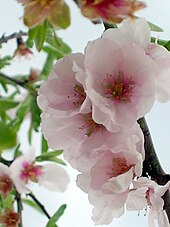The almond (Prunus dulcis, syn. Prunus amygdalus Batsch., Amygdalus communis L., Amygdalus dulcis Mill.), is a species of tree native to the Middle East and South Asia. Almond is also the name of the edible and widely cultivated seed of this tree. Within the genus Prunus, it is classified with the peach in the subgenus Amygdalus, distinguished from the other subgenera by the corrugated shell (endocarp) surrounding the seed.
 The fruit of the almond is not a true nut, but a drupe, consisting of an outer hull and a hard shell with the seed ("nut") inside. Shelling almonds refers to removing the shell to reveal the seed. Almonds are commonly sold shelled (i.e., after the shells are removed), or unshelled (i.e., with the shells still attached). Blanched almonds are shelled almonds that have been treated with hot water to soften the seedcoat, which is then removed to reveal the white embryo.
The fruit of the almond is not a true nut, but a drupe, consisting of an outer hull and a hard shell with the seed ("nut") inside. Shelling almonds refers to removing the shell to reveal the seed. Almonds are commonly sold shelled (i.e., after the shells are removed), or unshelled (i.e., with the shells still attached). Blanched almonds are shelled almonds that have been treated with hot water to soften the seedcoat, which is then removed to reveal the white embryo.Description
 The almond is a small deciduous tree, growing 4–10 metres (13–33 ft) in height, with a trunk of up to 30 centimetres (12 in) in diameter. The young twigs are green at first, becoming purplish where exposed to sunlight, then grey in their second year. The leaves are 3–5 inches long, with a serrated margin and a 2.5 cm (1 in) petiole. The flowers are white or pale pink, 3–5 cm (1–2 in) diameter with five petals, produced singly or in pairs before the leaves in early spring.
The almond is a small deciduous tree, growing 4–10 metres (13–33 ft) in height, with a trunk of up to 30 centimetres (12 in) in diameter. The young twigs are green at first, becoming purplish where exposed to sunlight, then grey in their second year. The leaves are 3–5 inches long, with a serrated margin and a 2.5 cm (1 in) petiole. The flowers are white or pale pink, 3–5 cm (1–2 in) diameter with five petals, produced singly or in pairs before the leaves in early spring. Almonds begin bearing an economic crop in the third year after planting. Trees reach full bearing after five to six years after planting. The fruit is mature in the autumn, 7–8 months after flowering.
 The almond fruit measures 3.5–6 cm (1–2 in) long. In botanical terms it is not a nut, but a drupe. The outer covering or exocarp, fleshy in other members of Prunus such as the plum and cherry, is instead a thick leathery grey-green coat (with a downy exterior), called the hull. Inside the hull is a reticulated hard woody shell (like the outside of a peach pit) called the endocarp. Inside the shell is the edible seed, commonly called a nut. Generally, one seed is present, but occasionally there are two.
The almond fruit measures 3.5–6 cm (1–2 in) long. In botanical terms it is not a nut, but a drupe. The outer covering or exocarp, fleshy in other members of Prunus such as the plum and cherry, is instead a thick leathery grey-green coat (with a downy exterior), called the hull. Inside the hull is a reticulated hard woody shell (like the outside of a peach pit) called the endocarp. Inside the shell is the edible seed, commonly called a nut. Generally, one seed is present, but occasionally there are two.Source, Images: http://en.wikipedia.org/wiki/Almond











0 comments:
Post a Comment